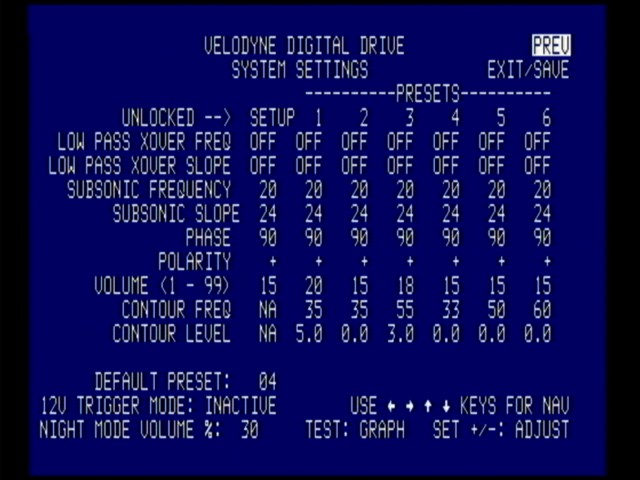|
There are just a few more features worthy of mention on the third OSD page, as
shown below.

Having configured the Setup column of global parameters, you can Lock them so you
won't accidentally change them.
As well as all the settings mentioned so far, each preset can have its own
default Volume and Contour settings. Contour is effectively an additional
ninth parametric EQ filter which can be used to boost (or cut) a single band
around a specific frequency. For example, with the factory default settings,
Preset 1 (Action/Adventure) has its default volume raised to make the sub
slightly "hot". The boost of +5 dB applied around 35 Hz gives an additional kick
to certain special effects. The precise values used in each of the presets are
entirely up to you, and any of them can be changed to suit your own tastes.
Preset 6 is treated differently, because all the equalization is disabled. By
flicking back and forth on the remote between Preset 6 and the equalized
settings in one of the other presets, you can easily hear the difference that
the equalization is making.
Night Mode can be toggled on/off by pressing a button on the remote. This
function limits the amount of deep bass produced by the sub for
neighbor-friendly viewing late at night. This is not just a crude fixed
bass-cut filter. Rather, it tracks the signal level and only starts to apply any cut
when the signal is above a certain level. The Night Mode Volume setting here
determines the threshold at which the dynamic compression starts to be
engaged. I found the default setting of 30% a little too aggressive in
practice and it may be worth increasing this value slightly to make the effect
more subtle if you want to use the feature.
The Sound
In my listening tests, I couldn’t assign any particular character to the basic sound
of the SMS-1 itself. It is essentially neutral. However, when flicking back
and forth to preset 6 (EQ disabled), the difference which the EQ is making can
be clearly heard.
I play classical church organ, so I know what the bottom octave of a 32 ft organ
stop should sound like. One of the problems I encountered in playing organ
recordings with my sub previously was that the room gain in my modest-sized
listening room led to that bottom octave being overblown. In a real church or
cathedral acoustic, those lowest notes produce an effect that is more felt
than heard. Reproducing that in the home is always going to be a tall order,
but with the SMS-1 taming the peaks in my original room response, some of the
effect can be realized without setting the whole room throbbing
unrealistically.
The dip in my original system response between 45 Hz and 63 Hz showed up very
clearly in rock music by killing much of its drive and energy. Bass guitar and
piano low notes sounded rather thin and anemic. With the SMS-1 boosting the dips, the
presentation became much more believable with the bass lines now far
easier to follow.
While the SMS-1 effects are generally easier to hear with music, action films also
benefit from the greater bass detail. Eliminating the
response peaks means that the subwoofer level can be increased overall to
bring it into better balance with the other speakers, making the bass clearer
and more distinct. With the modal peaks gone, dialog is still intelligible,
while music stands out better over explosions and other sound effects.
During some listening tests conducted at -10 dB below reference level with the
Master and Commander DVD, I discovered that the SMS-1 could push my subwoofer
beyond its limits. During the opening battle scene (chapter 4, 10:32), Russell
Crowe’s Jack Aubrey character shouts, "Fire", and several loud cannon shots
follow. I found that I could play this sequence fine with Preset 4
(Jazz/Classical) or 6 (No EQ), but if I engaged Preset 1 (Action/Adventure),
there were unmistakable signs of distress from the sub and I had to back off.
This is by no means the fault of the SMS-1. Even without it, I could have
produced a similar effect by running the sub too hot. Nor is it a criticism of
the sub, since every sub has a finite limit beyond which it is not sensible to
push it. It is simply the case that the combination of the EQ boosts
correcting dips in the response, taken together with Preset 1 which runs the
with a +5 dB contour boost at 35 Hz, proved too much.
The manual
contains several warnings to this effect. Before letting rip with one of these
demanding soundtracks, it would be prudent to set your master volume initially
low, and increase it cautiously until you are confident that your subwoofer
can take it all in its stride.
Conclusions
The SMS-1 is a serious audio processor at a reasonable price tag, and if you
consider buying one, you probably already have a good subwoofer. The SMS-1
will simply let you unleash its full potential. When it becomes time to
upgrade to a newer, bigger sub, the SMS-1 will still be around to help
integrate it. The ability to upgrade the software means it is unlikely to
become obsolete anytime soon. It can therefore be viewed as good value and a
sound long term investment.
This product has a very useful box of tricks. It will tell you things about your system
and room that you never knew before, and it provides you with a set
of tools from which you can select the most appropriate to fix your specific
problems. This is a great example of a product where the whole is far greater
than the sum of its parts. Once you get one, I guarantee you’ll wonder how you
ever managed without it.
- Roger
Welch –
Terms and Conditions of Use
|




